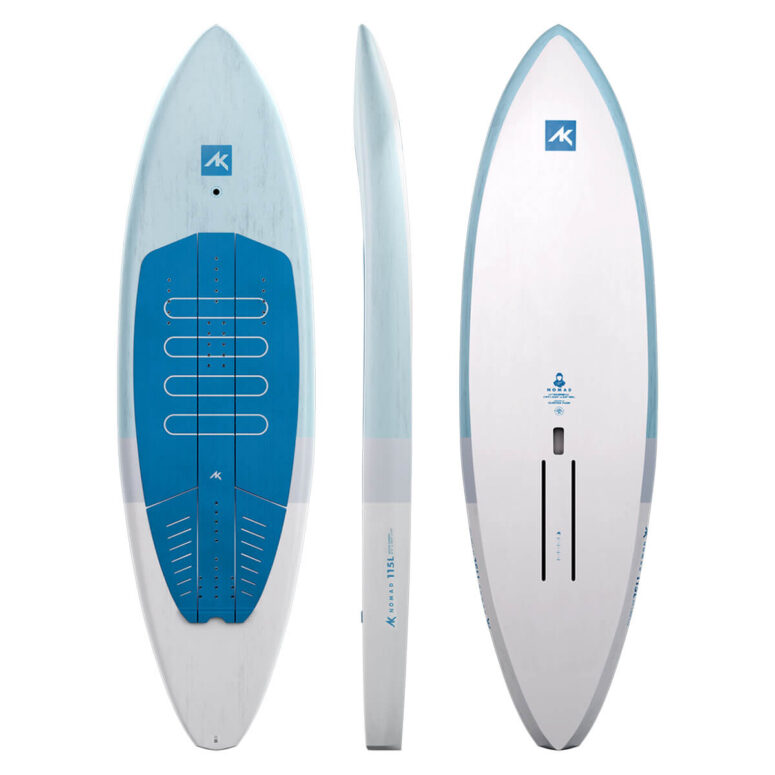

When you purchase gear through links on our site, we may earn a small commission. Here’s why you can trust our tests and our affiliate partner.

Downwinding is now most definitely a solid ‘thing’ and has sparked some interesting developments, pushing both foil and board design into some new realms in other disciplines. AK have been quick on the uptake and launched their DW-influenced lightwind wing board in the form of the Nomad.
They are running three sizes in 90L, 115L and 135L, with lengths running from 6’6, 7’0 and 7’6 respectively, and thicknesses all sitting between five and six inches. Width is quite literally a sticky subject with DW-derived boards, and the 115L board we tested sports 23” in its widest section making it a true crossover design and an elegant canoe-like outline. A full complement of foot strap inserts are present on self-tapping windsurf-style screws. These allow for a Y configuration or straight surf style and seem well placed with regards to the foil box – this is a nod towards the wingfoil intention of the board.
Shape-wise, the widest point is concentrated slightly front of center along the stringer. The nose has a gently domed top and some helicopter tape to protect where it will sit on the beach. The rear three quarters of the board are relatively flat, and the bulk of the rocker concentrates itself in the last quarter of the nose. The same goes for the chine, which is quite an aggressive angle in the rear of the board, and smooths itself as the rocker increases in the front of the board. The upper rail shape has a well-honed rounded bell-shaped top that tucks in and meets with the chine. This makes it a comfortable and practical board to handle for its thickness.
Underneath, it has an extra-long 14” foil box which sits in a forward position and will accommodate a truly massive range of foil types. The handle tucks in a well-balanced position into the foil box and makes your trot to the water’s edge a breeze.
Choosing your volume for winging, I’d definitely say go generously over your bodyweight to get the most out of the board; it’s designed to float so you can wait for a gust in marginal conditions, which is where it excels. If you’ve got downwind and SUP foil desires, perhaps choose well over your bodyweight, particularly if you’re in the fledgling stages.
All design attributes point towards early planing and we found this to be true across all disciplines. The nose penetrates surface chop well, and the board builds surface speed eagerly. The extra width over a pure DW board allows it decent surface stability. The takeoff seems to happen in one motion like a traditional wing board rather than sliding out like a pure DW, but the level of stability gained is invaluable in choppier water states. The deck pad is notably excellent, and super thin, comfortable and grippy. It tucks into a gentle concave in the deck making you feel planted and allowing you an idea of your foot placement without having to look down, with a kick in the rear to aid this further. The carbon construction translates feedback from the foil well, and paired with a decent carbon mast and forward box position, we found the pumping ability to be excellent for a board of this length. The forward box position means the board shrinks as soon as it flies. Sure, there’s a little more inertia present when initiating turns but it doesn’t feel horribly unwieldy.
The primary intention of the Nomad is definitely lightwind winging and, in this capacity, it absolutely excels, and also doubles as a decent option for a beginner as it has enough stability and is effortless to get on foil. For the more seasoned rider, it’s going to get you out in exceptionally marginal conditions, allow you to ride smaller foils and use smaller wings and be generally less power-hungry. For larger coastal expeditions, the Nomad’s volume will get you through the most mixed bag of conditions imaginable, and transfer into early stage downwinding. SUP foil and DW use are an obvious crossover benefit and it will certainly perform these tasks, perhaps ideally in the higher volumes. It’s a perfect board for longboard-style wingfoiling on a glassy summer’s evening, carving gentle turns or following weak swells downwind.
